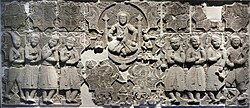Kangar union
(Tokhara Yabghus, Turk Shahis) Kangar union was a Turkic state in the territory of the entire modern Kazakhstan without Zhetysu.The Kengeres, mentioned in the Orkhon inscriptions, were possibly known in the Islamic world and in the west as Kangar, a collective name for three Pecheneg tribes (of eight).However, Golden objected that *Aoruša would have yielded Ors/Urs and Pritsak's opinion on the Kengeres-Kangars' ethnonym and mixed Tocharian-Iranian origin remained "highly hypothetical".[4] Other Orientalists, Marquart, Toltsov, Klyashtorny, attempted to connect the Kangar and Kengeres to the Qanglı, the eastern grouping of the Cuman-Kipchak confederation as well as the Indo-European Kangju in Chinese sources.[5] András Róna-Tas (1996, 1999) proposes that the Pechenegs associated with their word kongor meaning "brown" (referring to their horses' coat color) with the ethnic name Kangar, which had been in existence in the Caucasus region as early as the 6th century CE before the Turkic peoples emerged; though he considers it a "case of an ethnic name established by means of a popular etymology".
Old TurkicTengriismKhan (title)KurultaiFirst Turkic KhaganateWestern Turkic KhaganateKimak KhanateOghuz Yabgu StateHistory of the Turkic peoplesTurkic peoplesOnogursOghuz TurksSaragursUtigursBulgarsKutrigursKarluksKipchaksCherniye KlobukiUyghursTatarsKumyksYakutsDolgansKrymchaksCrimean KaraitesTurkic LanguagesTurkishAzerbaijaniKazakhUyghurTurkmenKyrgyzBashkirChuvashQasgqaiKarakalpakKarachay-BalkarGagauzKaraimKrymchakTurkic MythologyTengrismShamanismÜlgenErgenekonGrey wolfPre-14th centuryYenisei Kyrgyz PeopleYenisei Kyrgyz KhaganateDinglingTiele (Gaoche) GöktürksTokhara YabghusTurk ShahisEastern Turkic KhaganateSecond Turkic KhaganateSabiri PeopleKhazar KhaganateXueyantuoTurk ShahiTürgesh KhaganateKimek–Kipchak ConfederationUyghur KhaganateKarluk Yabgu StateKara-Khanid KhanateGanzhou Uyghur KingdomPecheneg KhanatesGhaznavid EmpireSeljuk EmpireSultanate of RumCuman–Kipchak ConfederationKhwarazmian EmpireKerait KhanateAtabegs of AzerbaijanDelhi SultanateMamluk dynastyKhalji dynastyTughlaq dynastyQarlughid KingdomGolden HordeMamluk Sultanate (Cairo)Bahri dynastyOttoman StateHistory of KazakhstanScythiaKangju KingdomRouranTurkic (Göktürks)KarlukKara-KhanidQara KhitaiMongol EmpireUzbek KhanateKazakh KhanatePost-nomadic periodRussian TurkestanGovernor-Generalship of the SteppesAlash AutonomyKirghiz ASSRKazakh ASSRKazakh SSRRepublic of KazakhstanCultureGeographyHealthcareReligionBuddhismEastern OrthodoxyJudaismOutline of Kazak military historyTurkicKazakhstanZhetysuearly medievalKanglyUyghur'sKypchaksOrkhon inscriptionsPechenegByzantineConstantine PorphyrogenitusOmeljan PritsakTocharian AΑορσοιMarquart